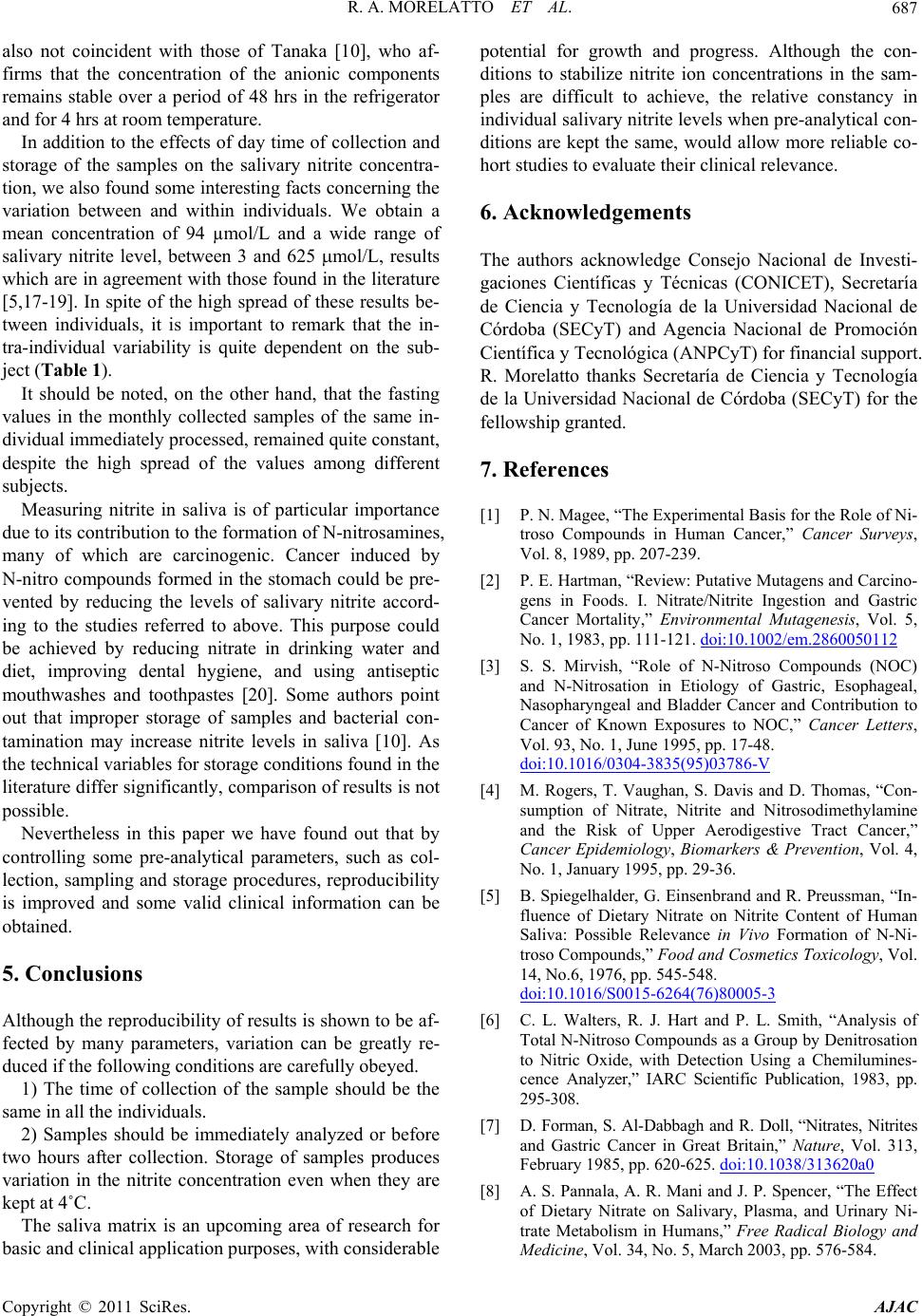
R. A. MORELATTO ET AL.687
also not coincident with those of Tanaka [10], who af-
firms that the concentration of the anionic components
remains stable over a period of 48 hrs in the refrigerator
and for 4 hrs at room temperature.
In addition to the effects of day time of collection and
storage of the samples on the salivary nitrite concentra-
tion, we also found some interesting facts concerning the
variation between and within individuals. We obtain a
mean concentration of 94 µmol/L and a wide range of
salivary nitrite level, between 3 and 625 mol/L, results
which are in agreement with those found in the literature
[5,17-19]. In spite of the high spread of these results be-
tween individuals, it is important to remark that the in-
tra-individual variability is quite dependent on the sub-
ject (Table 1).
It should be noted, on the other hand, that the fasting
values in the monthly collected samples of the same in-
dividual immediately processed, remained quite constant,
despite the high spread of the values among different
subjects.
Measuring nitrite in saliva is of particular importance
due to its contribution to the formation of N-nitrosamines,
many of which are carcinogenic. Cancer induced by
N-nitro compounds formed in the stomach could be pre-
vented by reducing the levels of salivary nitrite accord-
ing to the studies referred to above. This purpose could
be achieved by reducing nitrate in drinking water and
diet, improving dental hygiene, and using antiseptic
mouthwashes and toothpastes [20]. Some authors point
out that improper storage of samples and bacterial con-
tamination may increase nitrite levels in saliva [10]. As
the technical variables for storage conditions found in the
literature differ significantly, comparison of results is not
possible.
Nevertheless in this paper we have found out that by
controlling some pre-analytical parameters, such as col-
lection, sampling and storage procedures, reproducibility
is improved and some valid clinical information can be
obtained.
5. Conclusions
Although the reproducibility of results is shown to be af-
fected by many parameters, variation can be greatly re-
duced if the following conditions are carefully obeyed.
1) The time of collection of the sample should be the
same in all the individuals.
2) Samples should be immediately analyzed or before
two hours after collection. Storage of samples produces
variation in the nitrite concentration even when they are
kept at 4˚C.
The saliva matrix is an upcoming area of research for
basic and clinical application purposes, with considerable
potential for growth and progress. Although the con-
ditions to stabilize nitrite ion concentrations in the sam-
ples are difficult to achieve, the relative constancy in
individual salivary nitrite levels when pre-analytical con-
ditions are kept the same, would allow more reliable co-
hort studies to evaluate their clinical relevance.
6. Acknowledgements
The authors acknowledge Consejo Nacional de Investi-
gaciones Científicas y Técnicas (CONICET), Secretaría
de Ciencia y Tecnología de la Universidad Nacional de
Córdoba (SECyT) and Agencia Nacional de Promoción
Científica y Tecnológica (ANPCyT) for financial support.
R. Morelatto thanks Secretaría de Ciencia y Tecnología
de la Universidad Nacional de Córdoba (SECyT) for the
fellowship granted.
7. References
[1] P. N. Magee, “The Experimental Basis for the Role of Ni-
troso Compounds in Human Cancer,” Cancer Surveys,
Vol. 8, 1989, pp. 207-239.
[2] P. E. Hartman, “Review: Putative Mutagens and Carcino-
gens in Foods. I. Nitrate/Nitrite Ingestion and Gastric
Cancer Mortality,” Environmental Mutagenesis, Vol. 5,
No. 1, 1983, pp. 111-121. doi:10.1002/em.2860050112
[3] S. S. Mirvish, “Role of N-Nitroso Compounds (NOC)
and N-Nitrosation in Etiology of Gastric, Esophageal,
Nasopharyngeal and Bladder Cancer and Contribution to
Cancer of Known Exposures to NOC,” Cancer Letters,
Vol. 93, No. 1, June 1995, pp. 17-48.
doi:10.1016/0304-3835(95)03786-V
[4] M. Rogers, T. Vaughan, S. Davis and D. Thomas, “Con-
sumption of Nitrate, Nitrite and Nitrosodimethylamine
and the Risk of Upper Aerodigestive Tract Cancer,”
Cancer Epidemiology, Biomarkers & Prevention, Vol. 4,
No. 1, January 1995, pp. 29-36.
[5] B. Spiegelhalder, G. Einsenbrand and R. Preussman, “In-
fluence of Dietary Nitrate on Nitrite Content of Human
Saliva: Possible Relevance in Vivo Formation of N-Ni-
troso Compounds,” Food and Cosmetics Toxicology, Vol.
14, No.6, 1976, pp. 545-548.
doi:10.1016/S0015-6264(76)80005-3
[6] C. L. Walters, R. J. Hart and P. L. Smith, “Analysis of
Total N-Nitroso Compounds as a Group by Denitrosation
to Nitric Oxide, with Detection Using a Chemilumines-
cence Analyzer,” IARC Scientific Publication, 1983, pp.
295-308.
[7] D. Forman, S. Al-Dabbagh and R. Doll, “Nitrates, Nitrites
and Gastric Cancer in Great Britain,” Nature, Vol. 313,
February 1985, pp. 620-625. doi:10.1038/313620a0
[8] A. S. Pannala, A. R. Mani and J. P. Spencer, “The Effect
of Dietary Nitrate on Salivary, Plasma, and Urinary Ni-
trate Metabolism in Humans,” Free Radical Biology and
Medicine, Vol. 34, No. 5, March 2003, pp. 576-584.
Copyright © 2011 SciRes. AJAC